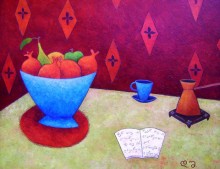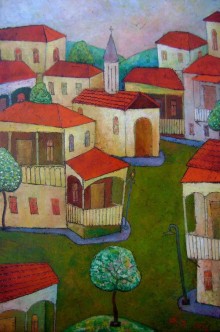In the high-mountain panorama of modern Ukrainian painting presented in the project “DIFFERENT – RIZNE,” Davyd Sharashydze’s summit attracts with its warmth of simple truths. After seeing his pictures at least once, we will recognize the manner of the artist and ask the author, “Where is this world located? There is no paradise on earth, but it is present in your pictures. How is it possible?”
The curtains fall one by one, and the answer becomes closer and more understandable. “Color of the sky, the blue color” (Nikoloz Baratashvili) and the red color, the color of pomegranate, appeal one to the way which leads to an ancient city. In its cozy streets there are houses under tiled roofs, where beautiful dames and noble knights live. They read poems, play musical instruments, and invite you to a refined banquet: on the tables there are fruits and wine, as well as flowers in old-time vases. And pomegranate trees are flourishing in the garden, and their fruits are floating in the sky.
Pomegranates are present in many of David’s paintings, if not the fruits, then the flowers. And if pomegranates are not in the canvas, they are ceramic and karmic, in the Buddhist meaning of the word. Bright, rich grains which encode the life, blood, and love. Examining the blessed pomegranate you will find in it the image of the universe, which is a whole in its versatility. And different nations consider it a symbol of spring and energy of the sun, fertility and abundance, revival and immortality, righteous descendants and happy future. The real food of gods, the spiritual fruit.
The artist told The Day about the colors of his pictures, their idea and subtext, as well as about his vision of present-day situation in Ukraine.
“FLOWERS OF CORNEL”
“I spent my childhood surrounded by nature – in the mansion of my grandparents, in the village Ozurgeti in western Georgia. There was a huge garden surrounded by mountains,” Davyd SHARASHYDZE recalls, “I spent days in the garden and saw the beautiful blossom of pomegranate trees, and in autumn, when the leaves fall, the fruits stay long on the branches. By the way, red is my color. The fruits in the white, blue, green, red-and-yellow background are the ‘Seasons’ cycle, just like Vivaldi’s. And the burgundy background – I call this color ‘the color of wine, ennobled by years,’ – is called in Georgian ‘the color of cornel.’ What attracts me is that the pomegranate fruits are different, like people, with their own moods and inner content. I keep constant contact with them and all subjects in the pictures and talk to them everyday.
“One day I understood that I could bring the items from the canvases to reality, enliven them, and I tried my hand in design. I bring the style, the manner, and the composition present in the canvas to a different background and different material. That is how the ceramic pomegranates emerged, the plates and the vase which depict them, and the tablecloth with pomegranates on a wrought table – we created it together with my friend, ceramicist Giya Miminoshvili. The frame, which master made of dark tree following my sketch, contains the motive present on another picture, in the pattern of the carpet I invented. That is how decor was brought from the picture to the framework.
“The concept of the project ‘DIFFERENT – RIZNE’ suggests that the pictures of the previous years created based on various impressions should be present. Therefore the exposition includes Old Tbilisi, French Roofs, and not only them. When I saw a red phone box for the first time in England, I understood that I would paint it, but I did this some two years later. Interestingly, it can be found both at the central street of London, and somewhere in the forest or in the field: a pedestrian path, green space, and suddenly a red spot, an art object. It stands in the green environment on a bank of a lake and probably two or three people use it in a week time, but the phone is working, and people do call. Englishmen can turn a simple everyday thing into something more valuable.”
WHERE WILL THE LIGHT COME FROM?
Sometimes I use the following method: if there is an open book in the picture, there must be something written in Georgian. It can be a poem or a maxim, like in the picture Morning Coffee: on the pages of the book one can read Marcus Aurelius’s famous words: ‘If I don’t flame, if you don’t flame, if we don’t flame, where will the light come from?’ And in the painting Books and Poetry I took Jean Cocteau’s words which Georgian poetess Anna Kalandadze used as an epigraph: ‘The accuser and the accused. The accuser is sitting in a chair. The accused is standing. You need to live your life standing.’ You cannot create when you sit and accuse, and when you stand, you are ready for movement and creative work. It is hard to live in such forms, but I think we should always remember about this. I have a work Chair: it is empty, someone looks at it and wants to sit down, but he does not – he needs to stand. This is a philosophical chair.
“Old town and portraits are not concrete towns and faces, but collective images. People live in such a town, they banquet at this table. In Georgia the meaning of a banquet is in uniting different people who sat down at the table not because they were hungry, but because they had something to tell one another. On the table there are only fruits and wine, and touching them ennobles people, helps people reveal themselves and in an open state speak about music, poetry, and life.
“There was a period in my life when I was seriously involved in photography and I am very thankful to my Lithuanian friend, teacher, and colleague Rimantas Dichavicius, who taught me proper vision and proper attitude to subjects. He said, ‘It does not matter what you do, it matters how you do this. And one more thing, you need to understand yourself and show this in your creative work.’”
“I AM A KYIVITE”
“When in the collapsing Soviet Union in the end of the 1980s the national movements started, I changed the artistic photography to documentary. I photographed much the Tbilisi events, gathered nearly 300 works – mine and those of my colleagues, printed and edited them, and the result was a collection for an exhibition. We showed our project in Georgia and in the Baltic states: when there was no Internet, people in such a way learned what was going on. We brought the exhibit to the Baltic states, when we were celebrating the anniversary of Georgian events, and six months later the same events took place in Vilnius, and there were victims. The citizens of the Baltic states know what effect it had on their lives and will never forget how Russia behaved then. Marches along central streets decorated with candles took place in Vilnius, Riga, and Tallinn.
“Having lived for 20 years in Kyiv, I can say that I am a Kyivite. By this words I want to say that I love this city, I care about its destiny, and I have a plenty of friends here. When I give exhibits in Europe, I underline that I am a citizen both of Georgia, and of Ukraine.
“Currently our country is experiencing a crucial, incredibly complicated moment. The west and east of Ukraine are very different, and over 20 years little have been done to shorten the distance between them. And Russia has made use of this. In the east there are people who want to separate, but can we demand them to understand the situation properly? This is the same as demanding a person who cannot read to understand Nietzsche. He must be taught how to read first. And to demand something from society, we need to invest something in it. But it did not meet the interest of Yanukovych’s government. Now together with deep concern for the destiny of Ukraine the hope emerged for changes for the better. Of course, it is impossible to do everything in a matter of one day, but there will be a result without doubt, we just should not deviate from the chosen path. The light of truth is like white color, it cannot be black. It can be painted over, but the rain will wash away the black color.”
David Sharazhydze’s exhibits have been held in France, Great Britain, Germany, Switzerland, the Czech Republic, the US. His works are present in private collections in 25 countries of the world.









